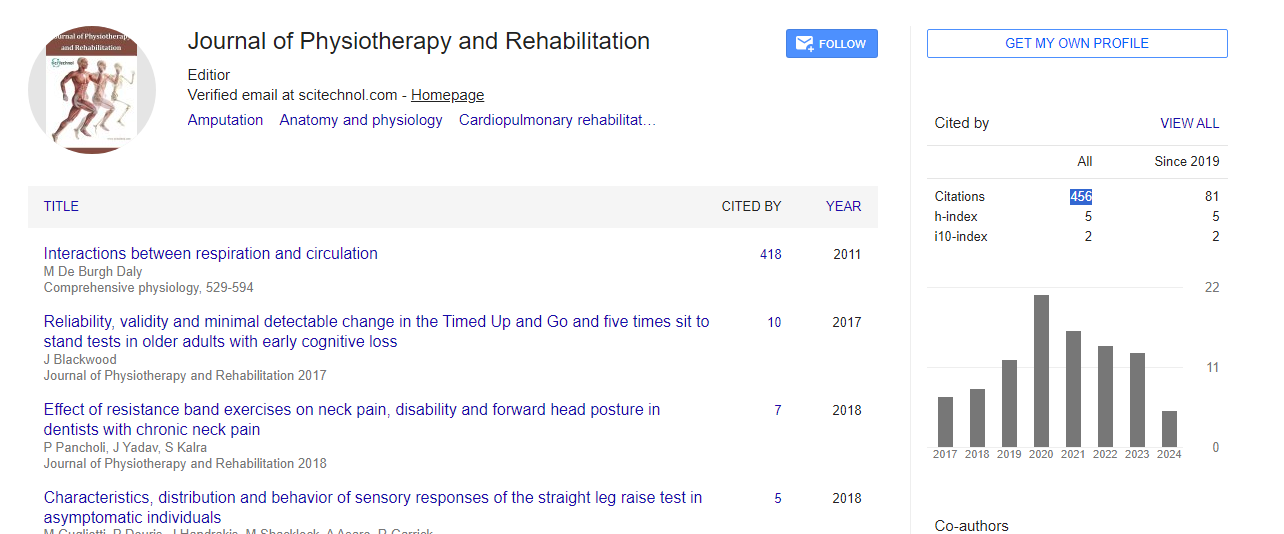Opinion Article, J Physiother Rehabi Vol: 8 Issue: 4
Role of Geriatric Physical Therapy in Managing Chronic Conditions: Strategies for Improving Function and Independence in Elderly Patients
Mursio Frazz*
1Department of Orthopaedic Surgery, University of Pittsburgh Medical Center, Pittsburgh, PA, USA
*Corresponding Author: Mursio Frazz,
Department of Orthopaedic Surgery,
University of Pittsburgh Medical Center, Pittsburgh, PA, USA
E-mail: frazzmu@rsio.edu
Received date: 23 July, 2024, Manuscript No. JPTR-24-147322
Editor assigned date: 25 July, 2024, PreQC No. JPTR-24-147322 (PQ);
Reviewed date: 08 August, 2024, QC No. JPTR-24-147322
Revised date: 15 August, 2024, Manuscript No. JPTR-24-147322 (R);
Published date: 22 August 2024, DOI: 10.4172/JPTR.1000178.
Citation: Frazz M (2024) Role of Geriatric Physical Therapy in Managing Chronic Conditions: Strategies for Improving Function and Independence in Elderly Patients. J Physiother Rehabi 8:4.
Abstract
Description
As the global population ages, managing chronic conditions in older adults has become an important concern in healthcare. Chronic conditions such as osteoarthritis, diabetes, heart disease and stroke can significantly impact the functional abilities and independence of elderly patients. Geriatric physical therapy plays a essential role in managing these conditions aiming to enhance mobility improve quality of life and promote independence. Chronic conditions in older adults often lead to a decline in physical function increased frailty and a higher risk of disability. Common issues include reduced mobility, pain, balance problems and decreased muscle strength. These challenges can affect daily activities such as walking, climbing stairs, and performing personal care tasks ultimately impacting overall quality of life.
Geriatric physical therapy focuses on addressing the unique needs of older adults by employing specialized techniques and strategies are changed to managing chronic conditions. The primary goals are to improve functional abilities reduce symptoms and enhance the patient's overall well-being. Effective management begins with a comprehensive assessment of the patient’s physical abilities limitations and specific chronic conditions. This evaluation helps physical therapists develop individualized treatment plans that address the patient’s goals and needs. Setting realistic and achievable goals is need for motivating patients and ensuring that therapy aligns with their personal priorities.
Exercise is fundmental of geriatric physical therapy. For patients with osteoarthritis, low-impact exercises such as swimming or cycling can reduce pain and improve joint function. Strength training exercises are essential for counteracting muscle loss and deficiency, which are common in older adults. Exercise programs are designed to be safe, effective and progressively challenging to promote sustained improvements in physical function. Falls are a significant concern for older adults, often resulting in serious injuries and decreased independence. Balance training exercises such as standing on one leg or practicing weight shifting help improve stability and reduce the risk of falls. Managing chronic pain is an essential aspect of physical therapy for elderly patients. Techniques such as manual therapy, modalities (e.g., heat and cold applications). Education on pain management strategies, including posture and body mechanics, empowers patients to manage pain more effectively and engage in daily activities with less discomfort.
Functional training focuses on improving the patient’s ability to perform daily activities independently. Therapists work with patients on specific tasks, such as getting in and out of a chair, dressing, or navigating stairs. By practicing these activities in a controlled and supportive environment, patients can build confidence and enhance their ability to perform them safely and efficiently at home.
Conclusion
Geriatric physical therapy plays an important role in managing chronic conditions and improving the functional abilities and independence of elderly patients. By focusing on personalized assessment, exercise prescription, balance and fall prevention, pain management, functional training and patient education therapists can enhance the quality of life for older adults. As the population ages, the importance of geriatric physical therapy in addressing chronic conditions and promoting autonomy will continue to grow offering valuable support and intervention for maintaining health and independence in later life.
 Spanish
Spanish  Chinese
Chinese  Russian
Russian  German
German  French
French  Japanese
Japanese  Portuguese
Portuguese  Hindi
Hindi 